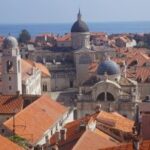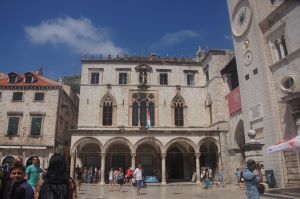I was looking for Ragusa
July 25-26, 2012
My contribution to our vacation (yes, David, I did become Scoutmaster because I couldn’t dictate family vacations!) was the Adriatic coast; I had wanted to explore this battleground between East and West for a long time. Carolyn, by contrast, wanted the Egypt-Israel part of this cruise. So yesterday, Ragusa, was on my bucket list.

 Justifiably so. If there’s anything better than being on the ocean or touring a fort, it’s touring a fort on the ocean. Only this fort encloses the old walled city of Ragusa. When it wasn’t enduring a major earthquake (1677) flattening the city, or substantial shelling from the Yugoslav army in 1991 (the “aggressors” our guide insisted), or under someone else’s rule (early, and after 1806, when it invited Napoleon’s troops in to prevent destruction of the city, which led to it becoming part of Austria after the Congress of Vienna in 1815, then part of Yugoslavia after the end of World War I, then part of Croatia after 1991), the city known then as Ragusa was an independent aristocratic republic ala Venice, which also claimed it for a time.
Justifiably so. If there’s anything better than being on the ocean or touring a fort, it’s touring a fort on the ocean. Only this fort encloses the old walled city of Ragusa. When it wasn’t enduring a major earthquake (1677) flattening the city, or substantial shelling from the Yugoslav army in 1991 (the “aggressors” our guide insisted), or under someone else’s rule (early, and after 1806, when it invited Napoleon’s troops in to prevent destruction of the city, which led to it becoming part of Austria after the Congress of Vienna in 1815, then part of Yugoslavia after the end of World War I, then part of Croatia after 1991), the city known then as Ragusa was an independent aristocratic republic ala Venice, which also claimed it for a time.

 The result is a sun-baked old city that is under UNESCO protection for its quaint collection of buildings, relics, and above all, the wall. The city’s saint is Vlaho in Slavic, Blasius in Latin, which rather indicates we’re on the edge between the East and West, still Catholic, but with a nod to its Byzantine heritage, and a little to its Slavic ancestry as well.
The result is a sun-baked old city that is under UNESCO protection for its quaint collection of buildings, relics, and above all, the wall. The city’s saint is Vlaho in Slavic, Blasius in Latin, which rather indicates we’re on the edge between the East and West, still Catholic, but with a nod to its Byzantine heritage, and a little to its Slavic ancestry as well.

 Three prominent sites were part of our tour—the Franciscan and Dominican chapels and monasteries, with one of the oldest pharmacies in Europe (the plagues and their aftermaths were the source of many of the churches in Europe) and the Cathedral with its relics—including gold-encased relics of St. Vlaho—his leg and arm. The star, however, was the city itself, and the prominent wall that surrounds the old city. The aqueduct system is a work of art as well, with world heritage reservoirs and fountains.
Three prominent sites were part of our tour—the Franciscan and Dominican chapels and monasteries, with one of the oldest pharmacies in Europe (the plagues and their aftermaths were the source of many of the churches in Europe) and the Cathedral with its relics—including gold-encased relics of St. Vlaho—his leg and arm. The star, however, was the city itself, and the prominent wall that surrounds the old city. The aqueduct system is a work of art as well, with world heritage reservoirs and fountains.
The only building on the main street from the glory days of the republic was a customs house; with a portico, it gave a hint of what the city must have looked like before the earthquake of 1677—Venetian. After the earthquake,  the other houses were rebuilt in a standard style, attractive, but without the frills of flamboyant Gothic and Renaissance period palaces. Interestingly, the old clock tower has a bell that rings on the hour—and three minutes later, giving a Mediterranean area comment on punctuality.
the other houses were rebuilt in a standard style, attractive, but without the frills of flamboyant Gothic and Renaissance period palaces. Interestingly, the old clock tower has a bell that rings on the hour—and three minutes later, giving a Mediterranean area comment on punctuality.
Ragusa’s claim to fame, though, was that it was a trading city, rather like Venice, but unlike Venice, sought to be neutral in war-torn Europe, rather like Switzerland with a fleet. Thus, the city had over 80 consulates at one time, and seems to have maintained good relations with Constantinople, even after that city fell into the hands of the Turks, a neutrality that lasted throughout the history of the Ragusa Republic (that is, until Napoleon ended its independence). It was the first “country” to recognize the independent United States.
If you are looking for Ragusa, you won’t find it on the maps today, though.  Its name now is Dubrovnik, the entrance on this cruise to a new world—Greece and the Middle East (or part of what was called the Orient). That’s one reason why, in our hour of free time, after circumnavigating the city on the wall, I ran back to catch the Jesuit Church—probably the last chance on this trip to view a Baroque church, and one that I was told was “the best Baroque church in town.” I am now Baroque!
Its name now is Dubrovnik, the entrance on this cruise to a new world—Greece and the Middle East (or part of what was called the Orient). That’s one reason why, in our hour of free time, after circumnavigating the city on the wall, I ran back to catch the Jesuit Church—probably the last chance on this trip to view a Baroque church, and one that I was told was “the best Baroque church in town.” I am now Baroque!